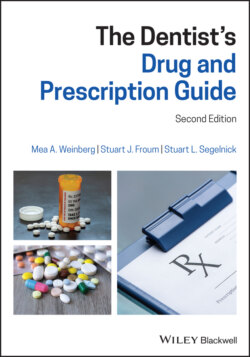Читать книгу The Dentist's Drug and Prescription Guide - Mea A. Weinberg - Страница 33
3.7 Patients with History of Bariatric Surgery
Оглавление1 Q. If a patient has undergone bariatric (weight reduction) surgery, does drug dosing need to be adjusted?
2 A. Yes. Altered drug absorption may occur after the Roux‐en‐Y gastric bypass surgical weight reduction procedure, which is a restrictive–malabsorptive procedure (the most commonly performed surgical procedure in obese people). This can be a concern post surgery because there is less surface area of the small intestine for drug absorption. For this reason, many patients may develop nutritional deficiencies especially in fat‐soluble vitamins E and D and also iron and vitamin B12. Drugs with long absorptive phases that remain in the intestine for extended periods are likely to exhibit decreased bioavailability in these patients (Miller and Smith 2006; Padwal et al. 2010). If you are concerned about altered drug absorption, it is recommended to use a drug that releases its active ingredient over an extended time (Seaman et al. 2005). Also, since individual dose adjustments may be needed, it is recommended to consult the patient's physician. These drugs include the following formulations: extended release (ER), sustained release (SR), delayed release or long‐acting (LA). Antibiotics supplied as delayed release include the following.Doxycycline delayed‐releaseSupplied: 75 mg, 100 mg cap, tab.Adults: 100 mg every 12 hours followed by a maintenance dose of 100 mg/day. The maintenance dose may be administered as a single dose or as 50 mg every 12 hours.Children: the recommended dosage for children weighing 4.5 kg (100 lb) or less is 2 mg/0.5 kg body weight divided into two doses on the first day of treatment, followed by 1 mg/0.5 kg body weight given as a single daily dose or divided into two doses on subsequent days. For more severe infections, up to 2 mg/0.5 kg body weight may be used. For children over 4.5 kg (100 lb), the usual adult dose should be used (www.rxlist.com/doryx‐drug.htm).Taken without regard to meals.Take with full glass of water.Do not take concurrently with antacids.If the capsule cannot be swallowed whole, it may be opened and the contents sprinkled over a spoonful of applesauce.ERYC® (erythromycin) delayed‐release capsulesSupplied: 250 mg cap.Adults: the usual dose is 250 mg every six hours taken one hour before meals. If twice‐a‐day dosage is desired, the recommended dose is 500 mg every 12 hours. Dosage may be increased up to 4 g/day, according to the severity of the infection.Children: the usual dosage is 30–50 mg/kg/day in divided doses.Additionally, it is best to use tablets that are enteric coated to protect the small stomach. It must be kept in mind that tablets must break down or disintegrate and capsules must open up before they can be absorbed. Tablets can be crushed if desired or a chewable tablet prescribed. A solution/suspension is already in an easily absorbable liquid form.When prescribing for dental indications, the following antibiotics and analgesics can be prescribed in a liquid or suspension formulation (remember to confirm if there are any precautions or contraindications for any of the following drugs before prescribing).Antibiotics available in liquid formulation for adult dosing are given in Table 3.20.Analgesics available in liquid form are given in Table 3.21.
3 Q. Are there any over‐the‐counter analgesic liquid formulations?
4 A. Yes, acetaminophen and ibuprofen. Table 3.20 Antibiotics available in liquid formulation for adult dosingRx amoxicillin suspension (250 mg/5 mL)Disp: 100 mL bottleSig: Take 4 teaspoonfuls po stat, followed by 2 teaspoonfuls q8hNote: amoxicillin is also available as extended‐release tablets and chewable tablets which can be given to this patient.Rx amoxicillin/clavulanic acid (Augmentin) 250/62.5/5 mLDisp: 100 mL bottleSig: Take 4 teaspoonfuls po stat, followed by 2 teaspoonfuls q8hRx penicillin V 250 mg/5 mLDisp: 100 mL bottleSig: Take 4 teaspoonfuls po stat, followed by 2 teaspoonfuls q6hRx clindamycin oral solution 75 mg/5 mLDisp: 100 mL bottleSig: Take 2–4 teaspoonfuls po q8hRx azithromycin oral suspensionDisp: one single dose packetaSig: Empty the entire contents of the packet into a glass of water (2 oz) and mix. After swallowing, add another 2 oz of water to the glass and mix and drink. This suspension should be consumed immediately.a One packet contains 1 g or 1000 mg of azithromycin.Table 3.21 Analgesics available in liquid formSource: Miller and Smith (2006).Rx acetaminophen/codeine suspension (Schedule V) (120 mg acetaminophen +12 mg codeine/5 mL)Disp: 8 fl. ozSig: Take one tablespoonful (15 mL) q4h as neededRx acetaminophen/hydrocodone oral solution (Lortab Elixir®) (hydrocodone bitartrate 7.5 mg and acetaminophen 500 mg/15 mL) (Schedule II)Disp: 8 fl. oz (Note: do not write for 1 bottle because it is supplied as 1 pint)Sig: Take one tablespoonful q4–6h as needed for pain(The total daily dosage for adults should not exceed 6 tablespoonfuls)
5 Q. Are there problems with drug absorption in patients who have had other types of bariatric surgery such as vertical‐banded (stapled) gastroplasty and adjustable gastric banding?
6 A. Vertical‐banded (stapled) gastroplasty and adjustable gastric banding are types of bariatric surgery that allow for weight loss by reducing stomach volume (restrictive procedures) and cause malabsorption, as does the Roux‐en‐Y gastric bypass. In restrictive procedures, the smaller volume of the stomach can prevent adequate disintegration of the dosage formulation (tablet/capsule) needed for drug bioavailability. The suggestions for the patient with a Roux‐en‐Y gastric bypass also apply for the restrictive surgical procedure (Weinberg and Segelnick 2009).
